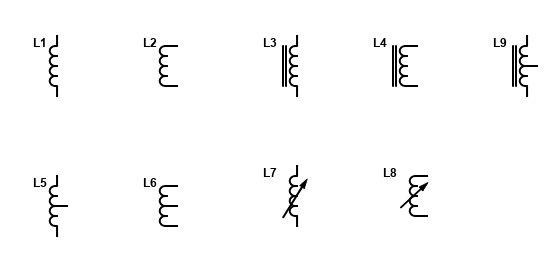Lesson 09 – Inductors

Welcome to Electronics For Fun
Lesson 9 – Inductors
As I introduce new terms, I have included a link to Wikipedia. Read ahead a little, and if you still need help you can click on any orange word below for more information than you probably want. 🙂
Inductors
An Inductor consists of a coil of wire wound around a core. The wire would have to be insulated so the windings would’t short out as they touched each other. Usually they use enamel coated wire, sometimes called magnet wire. The core may or may not have iron in it.
Inductors, also called chokes, temporarily store energy when a current flows thru it. Then when the current stops, they give that energy back to the circuit. If that sounds like a capacitor, it sort of is. But a capacitor does this by storing the energy electrostatically, whereas an inductor stores the energy in a magnetic field, or electromagnetically.


The photo above shows some different types of inductors. The symbols above show some different ways you might see an inductor in a schematic diagram. L1 and L2 are the same inductor, just with the leads drawn a different way. They are “air core” inductors (no iron). L3 and L4 are “iron core” as shown by the two additional lines. L5 and L6 are “center tapped” air core inductors. L7 and L8 are “variable” air core inductors, and finally, L9 is a center tapped iron core inductor.
Remember from our last lesson that a capacitor resists the flow of DC but freely allows AC to pass thru it. An inductor, on the other hand, resists changing current like AC, but allows DC to pass easily.
The amount of inductance in an inductor is measured in units called henrys. One henry is fairly large so usually, in electronics, we are dealing with microhenrys. A microhenry is one millionth of a henry, written as, for example 5µH. Sometimes we see a larger inductor specified as so many millihenrys. A millihenry is 1 thousanth of a henry, expressed as mH. So a 4 millihenry inductor would be written as 4mH.
Total Equivalent Inductance
The method of calculating the total equivalent inductance for inductors, is mostly like that of resistors. By that statement, I mean that to calculate series inductance, you just add them together like series resistors. Looking at the image below, assume we had just two inductors, L1 and L2. Assuming that L1 is 10µH and L2 is 5µH, the total equivalent inductance would be simply 10 + 5 or 15µH.

In the diagram below, once again let’s assume we have only two inductors, L1 and L2. Assuming that L1 is 10µH and L2 is 5µH, Leq, the total equivalent inductance would be calculated similar to the equation that we used for resistors in parallel and capacitors in series.

This time we will skip the fact that the equation was originally written for henrys. In the capacitor lesson, we proved we could just use microfarads instead of farads for the calculation as long as we realized that the answer would be in microfarads as well. The same holds true here so instead of converting the inductors values to henrys and then back again, we will just use microhenrys from start to finish.
So we would have 1/Leq=1/L1 + 1/L2 which would be 1/Leq=1/10 + 1/5 which would be 1/Leq=.1 + .2. Next would be 1/Leq=.3 and finally dividing 1 by .3 gives us 3.334 microhenrys or 3.334µH. Once again, if you don’t want to do the math, you can visit keisan.casio.com for an online equivalent inductance calculator .
Inductive Reactance
Inductive Reactance is like resistance, but in an inductor, it changes as the frequency changes. That’s because an inductor resists changing current like AC, but allows DC to pass easily. So, to calculate inductive reactance, also called impedance, we use the equation XL=2πfL where XL is the Inductive Reactance in ohms, π is 3.14, f is the frequency, and L is the inductance in henrys. So let’s say we have a 10mH inductor and a frequency of 1000 hertz. We would have XL=2πfL or XL=2 times 3.14 times 1000 times .010, which would be 62.8 ohms. You can visit 66pacific.com for an online inductive reactance calculator .
Test your knowledge if you feel like it with a little test. No cheating now!
Q1: An inductor stores the energy _____________.
Q2: A 3mH inductor and a 2mH inductor in series would be the equivalent of a __________ inductor.
Q3: Inductive Reactance is specified in ____________.

©2020 ElectronicsForFun.Com, Theme Design by Evolve Themes and Proudly Powered by WordPress